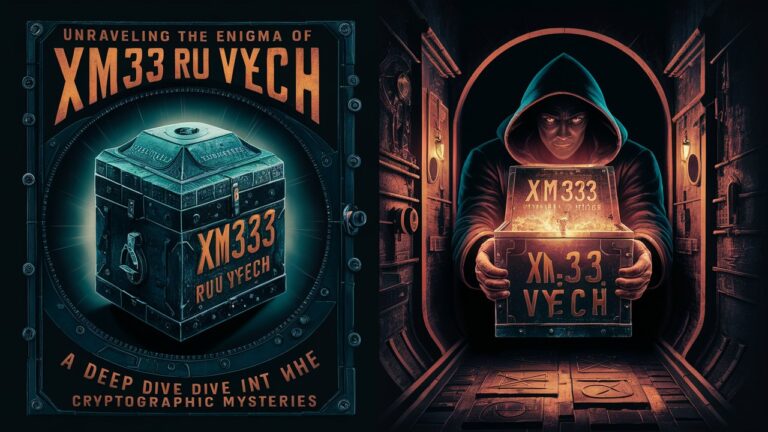Introduction
The cryptic string “XM333 RU VYECH” emerges like a digital cipher from the shadows of obscure online discourse, evoking intrigue and speculation across tech communities and cryptographic circles. At first glance, it appears as a random alphanumeric sequence, yet its structural symmetry hints at deliberate design—potentially encoding technical specifications, operational protocols, or even cultural references within niche subcultures. This article dissects each segment of this enigma, exploring plausible interpretations rooted in technology, linguistics, and cryptography. As we peel back its layers, we confront broader questions about how modern society generates, obscures, and decodes information in an age of digital ephemera. Whether a product code, a covert call sign, or an inside joke, XM333 RU VYECH serves as a microcosm of the internet’s enduring love affair with mystery.
XM333: The Alphanumeric Anchor
The prefix “XM333” grounds the phrase in a legacy of technical nomenclature. Historically, “XM” prefixes denote experimental models across industries—from military hardware (e.g., XM-25 grenade launcher) to audio technology (e.g., Sony’s XM-series headphones). The triplet “333” amplifies this technical aura; in binary logic, triple repetitions often signify error codes or debug sequences in low-level programming. Alternatively, numerology imbues 333 with mystical weight—associating it with cosmic alignment or spiritual awakening in esoteric traditions. In a pragmatic lens, XM333 could represent a versioned prototype: X for experimental, M for module, and *333* as its iteration. This duality between technical precision and symbolic resonance makes it a versatile anchor, suggesting either a tangible device or a metaphorical key to deeper intellectual exploration.
RU: Geopolitical or Linguistic Nexus?
“RU” thrusts the phrase into geopolitical and linguistic ambiguity. As the ISO 3166 country code for Russia, “RU” immediately evokes associations with Eastern European technology sectors—think Kaspersky Lab or Russian aerospace innovations. This angle frames XM333 RU VYECH as a potential artifact of Slavic tech culture, perhaps referencing a discontinued Soviet-era tool or a contemporary cyber initiative. Linguistically, however, “RU” fractures into colloquial web slang: “Are You?”—a fragment of chat shorthand probing participation (e.g., “RU ready?”). This transforms the phrase into an interrogative, challenging the recipient to engage with “VYECH.” The tension between these readings—national identifier versus participatory prompt—exemplifies how context collapses in digital spaces. Is it a geographic tag, a linguistic glitch, or a deliberate double entendre? The answer depends entirely on the observer’s lens.
VYECH: The Cryptographic Climax
“VYECH” stands as the most elusive segment, resisting immediate classification. Phonetically, it echoes Slavic verbs: the Russian “вечь” (vyech’) approximates “to eternalize” or “to perpetuate,” while Czech “věč” suggests “eternity.” This positions VYECH as a poetic flourish—imbuing the phrase with themes of permanence within transient digital realms. Conversely, applied cryptography offers a grittier interpretation: “VY” may signal “Verification Yield,” a term for consensus outputs in blockchain protocols, while “ECH” could denote “Encrypted Cryptographic Hash.” Under this model, XM333 RU VYECH morphs into a validation command for a hypothetical system where XM333 devices (RUnning in RUssia?) authenticate data via hashing. The beauty of VYECH lies in its resistance to monoculture; it is a Rorschach test for the decoder, reflecting their expertise—be it linguistics, software engineering, or meme semiotics.
Synthesis: XM333 RU VYECH as a Cultural Artifact
When amalgamated, these components transcend literal sum. XM333 RU VYECH could prototype a Russian cryptographic tool (XM333) designed for eternalized data verification (VYECH). Alternatively, it might parody techno-jargon—a meme critiquing security theater in infosec circles. Culturally, it mirrors phenomena like Cicada 3301 or “The Game” (where “RU” famously signals loss), leveraging obscurity to forge in-group belonging. Philosophically, the triad structure—model (XM333), origin/query (RU), action/outcome (VYECH)—echoes ritual incantations, transforming cold code into a talisman for the digital age. Its persistence in forums demonstrates how humans crave patterns, even in chaos: we want XM333 to be a drone’s serial number or a hacker’s signature because mystery without resolution unsettles our empirical instincts.
Conclusion: The Endurance of Enigmas
XM333 RU VYECH epitomizes the internet’s capacity to generate meaning from ambiguity. Whether dismissed as gibberish or exalted as a cipher, its power derives from the conversations it spawns—uniting linguists, programmers, and conspiracy theorists in collaborative decoding. This phrase reminds us that technology alone cannot demystify human creativity; context, culture, and curiosity are the true keys. As we advance toward AI-dominated communication, artifacts like XM333 RU VYECH preserve the thrill of the unsolved, challenging us to revel in questions without answers. In the end, the journey through its letters matters more than any destination.
Frequently Asked Questions
Q: Is XM333 RU VYECH linked to real technology?
A: While no verified product matches this name, its structure aligns with industry naming conventions. It could reference an obscure prototype, a fictional entity in cyberpunk lore, or an inside joke within tech communities.
Q: Could “RU VYECH” mean “Are you eternal?” in code?
A: Linguistically plausible! “RU” as “Are You” + “VYECH” as a Slavic-rooted “eternal” creates a poetic query on digital legacy. This interpretation leans into existential themes in tech ethics.
Q: Why do such cryptic phrases gain traction online?
A: They fulfill psychological needs: puzzle-solving as mental exercise, communal decoding as social bonding, and the allure of “hidden knowledge” in an information-saturated world.
Q: How can I decode similar phrases?
A: Break them into segments. Research prefixes/suffixes in tech, linguistics, and cryptography. Contextualize using geographic or cultural clues. Embrace ambiguity—not all codes have single solutions.
Q: Is this related to cybersecurity threats?
A: Unlikely. While hackers use obfuscated terms, XM333 RU VYECH lacks malware signatures or dark web associations. It’s probably artistic or academic rather than malicious.
Q: What’s the most credible theory about its origin?
A: Leading hypotheses include: a) a defunct Soviet tech code, b) an ARG (Alternate Reality Game) puzzle, or c) generative nonsense from AI/chat forums. Without primary sources, all remain speculative.
